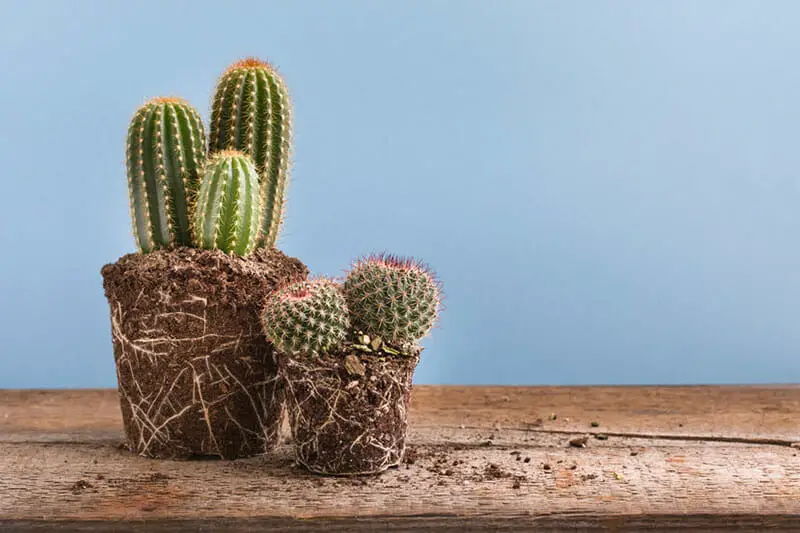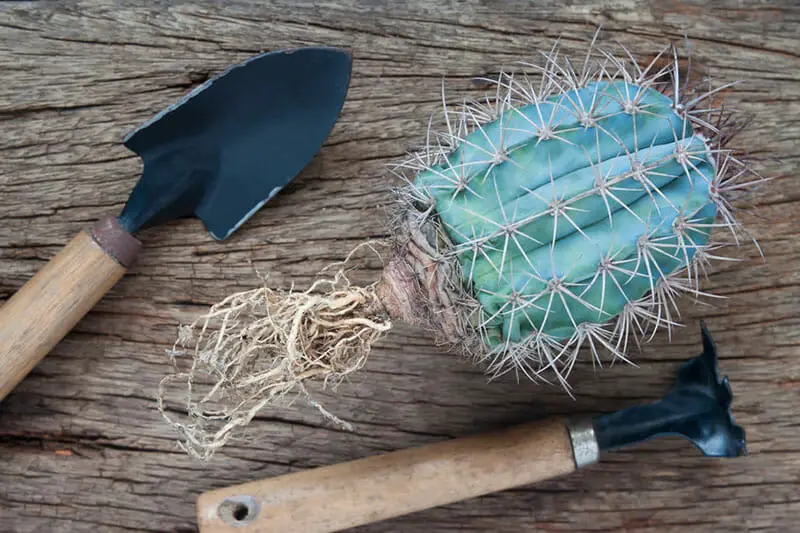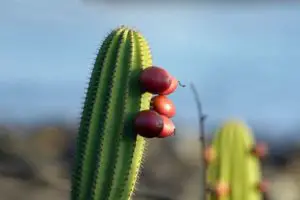If you have ever driven through a desert, you might have wondered how cacti survive the extreme elements of the desert and whether or not they have roots.
Do Cacti have roots?
Cacti do indeed have roots. In fact, they may have multiple types of roots that, in conjunction with the body of the cactus, enable them to survive harsh desert conditions.
Cacti are incredible and diversified plants. There is much to know about how their roots aid in their survival.

What Do Cacti Roots Look Like?
Having grown many different species of cacti, I can tell you that each one has its own unique character, both on the outside and when it comes to their roots.
Many cacti have long fibrous roots that look like strands of air.
These roots are typically extensive systems spread laterally away from the plant.
In the desert these roots tend to be shallow, while in areas that receive more precipitation and where there is more competition, the roots will be deeper as they try to compete and find necessary water and nutrients.
Others, such as the barrel cacti have shallower root systems that are more compact, allowing them to collect dew water that falls from the cacti.
While this may not seem like enough water to sustain a plant, the cacti has evolved to survive on such small amounts of water by absorbing as much of it as possible through its root system.
There are multiple types of roots that can make up the root system of a cacti.
These different types of roots each contribute to the ability of cacti to survive in a wide range of conditions.
Roots of Survival: How Different Types Of Roots Help Cacti Survive

While you might not know it just by looking at a ball of cacti roots, there are different types of roots that each serve their own purpose.
Depending on the species, a cactus might have one or more of the following types of roots: aerial, lateral, or taproots.
Aerial Roots
Aerial roots grow from some species of cacti, but not all. You will only see aerial roots on species that have stems, such as the Christmas cactus and climbing species like the orchid cacti and night-blooming cereus.
Usually you will see them where the leaves originate from.
They are typically white, but they can also be pink.
If a cactus is not getting enough water through its roots in the soil, but the atmosphere is humid, aerial roots can start to grow in an effort to collect the water from the surrounding atmosphere.
Like many other plants, a cactus relies on its roots for water. So, it’s not surprising that if there is not enough moisture in the soil, but the air is humid, that a cactus would sprout aerial roots to try and capture that moisture.
These roots may also serve as an anchor for climbing cacti as they grip onto rocks and trees.
Taproots
Taproots are long thick roots that extends downwards.
They help anchor the plant and enable it to reach water and nutrients located further down in the subsurface layers of the soil.
The taproot is the first root to form after germination and is the backbone of the root system.
The taproot arises form the radicle, also known as the embryonic root.
Secondary, tertiary, and other lateral roots then branch off the taproot as it continues to grow.
The taproot is also thicker than the other roots and lasts throughout the life of the cactus.
Lateral Roots
The majority of cactus roots are lateral roots, also known as adventitious roots.
Lateral roots are extensive systems of outward growing roots that branch off in all directions from the primary root, or taproot.
These roots are essential to the survival of cacti, especially in the desert. They are typically short lived compared to the primary root.
Lateral roots tend to be shallow surface feeders and are the majority of what you see in a ball of roots.
They are thin and hair like and form in clusters.
This allows them to absorb as much water as possible when it rains.
Lateral roots most often occupy only the first three inches of soil where they are able to quickly absorb water even from a light right.

An example of this can be seen in the saguaro cactus, at just over 4 inches tall it can have a root system with a spread up to 7 feet but won’t go below the first 4 inches of soil.
A full-grown saguaro cactus can have roots that are over 50 feet.
The roots of a cactus are essential for its survival.
In a cohesive relationship with the body, the shallow roots of a cactus collect as much water as possible when it rains.
That water is then stored within the body of the cactus and the taproot, which is then used during dry spells.
This is how a cactus can survive years without rainfall.
Unlike most plants, cactus do not have true leaves. They have what are called modified leaves in the form of spines and scales. In a typical plant the stomata are located on the leaves, but in cactus they are located on the body or stem of the plant.
Stomata on cacti work differently that those on regular plants. Instead of opening during the day, the stomata on a cactus open at night.
This ensures that they do not loose valuable water to the heat of the desert.
Adapted To Desertic Conditions

Cacti have developed several ways to adapt to the harsh conditions of the desert. In addition to their unique differences in how their stomata work, the stem also has a waxy coating that helps to keep the water in the cactus.
The roots of a cactus are able to adapt to conditions in real time.
During wet periods a cactus will grow more roots to absorb as much water as possible. During dry spells the cactus will essentially “cut off” roots to prevent loss of water to the surrounding soil and preserve its water supply.
The modified leaves of cacti also play a role in their ability to withstand desert conditions. Spines can provide bits of shade to the body of the cactus, which aids in its conservation of water.
The spines can also collect dew, which can then be collected by the shallow root system as it runs off the plant.
White spines deflect sunlight, keeping the cactus cooler and further preserving its water supply.
Cacti that have taproots, such as the giant Mexican cereus, are not only able to reach water and nutrients located in subsoil layers, but also able to store food and water in those taproots underground, away from the heat and dry air of the desert.
The taproot also helps to anchor the plant, keeping it from blowing down during high wind events.
Some taproots can be larger in mass than the cactus itself.
All these traits not only make cacti highly adaptable in dry desert conditions, but also make them easy to care for house plants.
Whether a cactus has just a few large taproots or a large system of fibrous lateral roots, they serve the same purpose.
To collect as much water as possible.
Do you have a question about cactus roots or knowledge to share? Share your thoughts and questions in the comments below🙏🏻.



I left a cactus in a pot too long and the roots wrapped around and around and filled the pot. The bottom of the plant is really drooping. Anyone tell me what to do? It is about 2 ft. tall. Thanksl
I don’t have a cactus, but I know many things about them. I’d prefer to get a bigger pot.
is cactus fruit edible?how?can you cook it or use it as a vegetables?